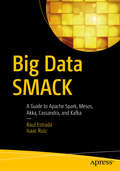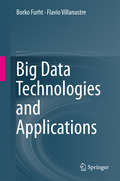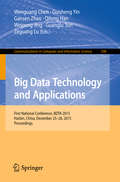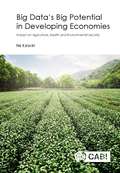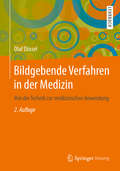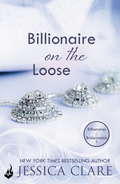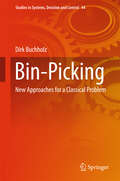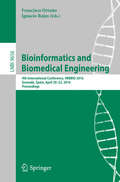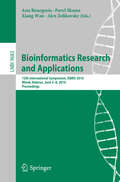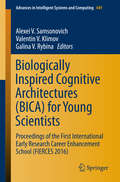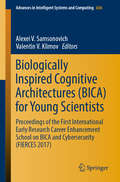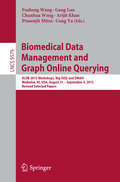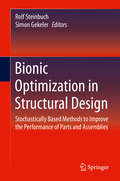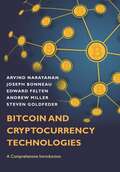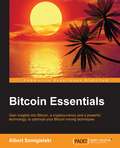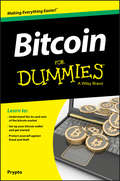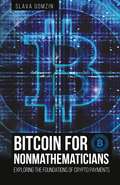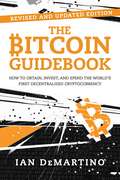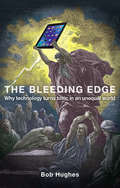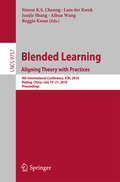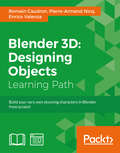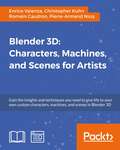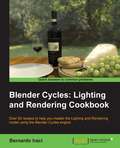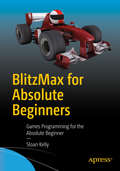- Table View
- List View
Big Data SMACK: A Guide to Apache Spark, Mesos, Akka, Cassandra, and Kafka
by Raul Estrada Isaac RuizLearn how to integrate full-stack open source big data architecture and to choose the correct technology--Scala/Spark, Mesos, Akka, Cassandra, and Kafka--in every layer. Big data architecture is becoming a requirement for many different enterprises. So far, however, the focus has largely been on collecting, aggregating, and crunching large data sets in a timely manner. In many cases now, organizations need more than one paradigm to perform efficient analyses. Big Data SMACK explains each of the full-stack technologies and, more importantly, how to best integrate them. It provides detailed coverage of the practical benefits of these technologies and incorporates real-world examples in every situation. This book focuses on the problems and scenarios solved by the architecture, as well as the solutions provided by every technology. It covers the six main concepts of big data architecture and how integrate, replace, and reinforce every layer: The language: Scala The engine: Spark (SQL, MLib, Streaming, GraphX) The container: Mesos, Docker The view: Akka The storage: Cassandra The message broker: Kafka What You Will Learn: Make big data architecture without using complex Greek letter architectures Build a cheap but effective cluster infrastructure Make queries, reports, and graphs that business demands Manage and exploit unstructured and No-SQL data sources Use tools to monitor the performance of your architecture Integrate all technologies and decide which ones replace and which ones reinforce Who This Book Is For: Developers, data architects, and data scientists looking to integrate the most successful big data open stack architecture and to choose the correct technology in every layer
Big Data Technologies and Applications
by Borko Furht Flavio VillanustreThe objective of this book is to introduce the basic concepts of big data computing and then to describe the total solution of big data problems using HPCC, an open-source computing platform. The book comprises 15 chapters broken into three parts. The first part, Big Data Technologies, includes introductions to big data concepts and techniques; big data analytics; and visualization and learning techniques. The second part, LexisNexis Risk Solution to Big Data, focuses on specific technologies and techniques developed at LexisNexis to solve critical problems that use big data analytics. It covers the open source High Performance Computing Cluster (HPCC Systems®) platform and its architecture, as well as parallel data languages ECL and KEL, developed to effectively solve big data problems. The third part, Big Data Applications, describes various data intensive applications solved on HPCC Systems. It includes applications such as cyber security, social network analytics including fraud, Ebola spread modeling using big data analytics, unsupervised learning, and image classification. The book is intended for a wide variety of people including researchers, scientists, programmers, engineers, designers, developers, educators, and students. This book can also be beneficial for business managers, entrepreneurs, and investors.
Big Data Technology and Applications: First National Conference, BDTA 2015, Harbin, China, December 25-26, 2015. Proceedings (Communications in Computer and Information Science #590)
by Qilong Han Weipeng Jing Guanglu Sun Zeguang Lu Wenguang Chen Guisheng Yin Gansen ZhaoThis bookconstitutes the refereed proceedings of the First National Conference on BigData Technology and Applications, BDTA 2015, held in Harbin, China, in December2015. The 26revised papers presented were carefully reviewed and selected from numeroussubmissions. The papers address issues such as the storage technology of Big Data;analysis of Big Data and data mining; visualization of Big Data; the parallelcomputing framework under Big Data; the architecture and basic theory of BigData; collection and preprocessing of Big Data; innovative applications in someareas, such as internet of things and cloud computing.
Big data's big potential in developing economies: impact on agriculture, health and environmental security
by Nir KshetriBig data involves the use of sophisticated analytics to make decisions based on large-scale data inputs. It is set to transform agriculture, environmental protection and healthcare in developing countries. This book critically evaluates the developing big data industry and market in these countries and gives an overview of the determinants, performances and impacts. The book provides a detailed analysis of technology creation, technology infrastructures and human skills to utilize big data in these countries. It discusses novel applications and business models involving big data to overcome healthcare barriers. The book also offers an analysis of big data's potential to improve environmental monitoring and protection. It posits that big data is likely to have far-reaching and profound impacts on the agricultural sector. A key question addressed is also how gains in agricultural productivity associated with big data will benefit smallholder farmers relative to global multinationals in that sector. It also probes big data's roles in the creation of markets that can improve the welfare of smallholder farmers. The book gives special consideration to big data-led transformation of the financial industry and discusses how the transformation can increase small-holder farmers' access to finance by changing the way lenders assess creditworthiness of potential borrowers. It also takes a look at data privacy and security issues facing smallholder farmers and reviews differences in such issues in industrialized and developing countries. The key ideas, concepts and theories presented are explored, illustrated and contrasted through in-depth case studies of developing world-based big data companies and deployment and utilization big data in agriculture, environmental protection and healthcare.
Bildgebende Verfahren in der Medizin: Von der Technik zur medizinischen Anwendung
by Olaf DösselDieses erfolgreiche Standardwerk beschreibt s#65533;mtliche bildgebenden Verfahren von der R#65533;ntgentechnik #65533;ber den Ultraschall bis zu den Methoden der Tomographie. Es werden sowohl die technischen Grundlagen als auch die medizinischen Anwendungen erl#65533;utert. Das Lehrbuch zeichnet sich aus durch eine verst#65533;ndliche Darstellung, zahlreiche Illustrationen der grundlegenden Prinzipien sowie durch Bilder von den verschiedenen Modalit#65533;ten und von den Ger#65533;ten. Die 2. Auflage wurde aktualisiert und enth#65533;lt neue Trends und Entwicklungen, insbesondere beim R#65533;ntgen und Ultraschall. Kapitel #65533;ber Magnetic Particle Imaging (MPI) wurden hinzugef#65533;gt.
Billionaire on the Loose: Billionaires and Bridesmaids 5 (Billionaires and Bridesmaids #5)
by Jessica ClareEnter the illustrious world of Jessica Clare's billionaires and bridesmaids. Fans of J.S. Scott, Louise Bay and Melody Anne will addicted to this sizzling, coveted New York Times bestseller. You met the six bachelors of the Billionaire Boys Club... Now it's time to pair up some filthy-rich billionaires with lucky ladies in waiting and enjoy the spoils... Taylor is a genius when it comes to computers, but understanding the opposite sex is beyond her. Because she always fumbles her flirtations, she needs help in finding her Prince Charming. So when her friend, Gretchen, sets her up as a tour guide for a new guy in town, she says yes despite her misgivings.She just doesn't expect Mr. Charming to actually be royalty...A faction in his country wants him to be king, but Loch has no intention of taking the crown. To keep from being named as the next successor, he hatches a scheme to marry a totally unacceptable American woman. Quirky Taylor seems like the perfect person for the job, until Loch realizes he likes more about her than her ability to keep him off the throne.When Loch's secret schemes come out, his chance of happiness with Taylor are blown - unless he can find a way to get the nerdy object of his affection to believe she's truly the queen of his heart... Includes a teaser for The Billionaire's Favourite Mistake!After more dazzling romance? Look out for the rest of the Billionaire and Bridesmaids series starting with The Billionaire And The Virgin or take a spin with the steamy Billionaire Boys Club starting with Stranded With A Billionaire.
Bin-Picking: New Approaches for a Classical Problem (Studies in Systems, Decision and Control #44)
by Dirk BuchholzThis bookis devoted to one of the most famous examples of automation handling tasks -the "bin-picking" problem. To pick up objects, scrambled in a box is aneasy task for humans, but its automation is very complex. In this book threedifferent approaches to solve the bin-picking problem are described, showinghow modern sensors can be used for efficient bin-picking as well as how classicsensor concepts can be applied for novel bin-picking techniques. 3D pointclouds are firstly used as basis, employing the known Random Sample Matchingalgorithm paired with a very efficient depth map based collision avoidancemechanism resulting in a very robust bin-picking approach. Reducing thecomplexity of the sensor data, all computations are then done on depth maps. This allows the use of 2D image analysis techniques to fulfill the tasks andresults in real time data analysis. Combined with force/torque and accelerationsensors, a near time optimal bin-picking system emerges. Lastly, surface normalmaps are employed as a basis for pose estimation. In contrast to knownapproaches, the normal maps are not used for 3D data computation but directlyfor the object localization problem, enabling the application of a new class ofsensors for bin-picking.
Bioinformatics and Biomedical Engineering: 4th International Conference, IWBBIO 2016, Granada, Spain, April 20-22, 2016, Proceedings (Lecture Notes in Computer Science #9656)
by Ignacio Rojas Francisco OrtuñoThis book constitutes the refereed proceedings of the 4th International Conference on Bioinformatics and Biomedical Engineering, IWBBIO 2016, held in Granada, Spain, in April 2016. The 69 papers presented were carefully reviewed and selected from 286 submissions. The scope of the conference spans the following areas: bioinformatics for healthcare and diseases; biomedical image analysis; biomedical signal analysis; computational systems for modeling biological processes; eHealth; tools for next generation sequencing data analysis; assistive technology for people with neuromotor disorders; fundamentals of biological dynamics and maximization of the information extraction from the experiments in the biological systems; high performance computing in bioinformatics, computational biology and computational chemistry; human behavior monitoring, analysis and understanding; pattern recognition and machine learning in the -omics sciences; and resources for bioinformatics.
Bioinformatics and Computational Biology in Drug Discovery and Development
by William T. LogingComputational biology drives discovery through its use of high-throughput informatics approaches. This book provides a road map of the current drug development process and how computational biology approaches play a critical role across the entire drug discovery pipeline. Through the use of previously unpublished, real-life case studies the impact of a range of computational approaches are discussed at various phases of the pipeline. Additionally, a focus section provides innovative visualisation approaches, from both the drug discovery process as well as from other fields that utilise large datasets, recognising the increasing use of such technology. Serving the needs of early career and more experienced scientists, this up-to-date reference provides an essential introduction to the process and background of drug discovery, highlighting how computational researchers can contribute to that pipeline.
Bioinformatics Research and Applications: 12th International Symposium, ISBRA 2016, Minsk, Belarus, June 5-8, 2016, Proceedings (Lecture Notes in Computer Science #9683)
by Anu Bourgeois Pavel Skums Xiang Wan Alex ZelikovskyThis book constitutes the proceedings of the 12th International Symposium on Bioinformatics Research and Applications, ISBRA 2016, held in Minsk, Belarus, in June 2016. The 25 papers presented in this volume were carefully reviewed and selected from 77 submissions. They were organized in topical sections named: next generation sequencing data analysis; protein-protein interactions and networks; protein and RNA structure; phylogenetics; sequence analysis; and statistical methods.
Biologically Inspired Cognitive Architectures: Proceedings of the First International Early Research Career Enhancement School (FIERCES 2016) (Advances in Intelligent Systems and Computing #449)
by Alexei V. Samsonovich Valentin V. Klimov Galina V. RybinaThis book presents cutting-edge research focused on current challenges towards the realization of Biologically Inspired intelligent agents, or Cognitive Architectures (BICA). The chapters are written by both world-recognized experts (including Antonio Chella, Olivier Georgeon, Oliver Kutz, Antonio Lieto, David Vernon, Paul Verschure, and others) and young researchers. Together, they constitute a good mixture of new findings with tutorial-based reviews and position papers, all presented at the First International Early Research Career Enhancement School on Biologically Inspired Cognitive Architectures (FIERCES on BICA 2016), held April 21-24 in Moscow, Russia. Most works included here cross boundaries between disciplines: from neuroscience to social science, from cognitive science to robotics, and from bioengineering to artificial intelligence. A special emphasis is given to novel solutions to urgent problems that have been resisting traditional approaches for decades. Intended for providing readers with an update on biologically inspired approaches towards the computational replication of all the essential aspects of the human mind (the BICA Challenge), this book is expected to foster lively discussions on the topic and stimulate cross-disciplinary, cross-generation and cross-cultural collaboration.
Biologically Inspired Cognitive Architectures: Proceedings of the First International Early Research Career Enhancement School on BICA and Cybersecurity (FIERCES 2017) (Advances in Intelligent Systems and Computing #636)
by Valentin V. Klimov Alexei V. SamsonovichThis book presents cutting-edge research focused on current challenges towards the realization of Biologically Inspired intelligent agents, or Cognitive Architectures (BICA). The chapters are written by both world-recognized experts (including Antonio Chella, Olivier Georgeon, Oliver Kutz, Antonio Lieto, David Vernon, Paul Verschure, and others) and young researchers. Together, they constitute a good mixture of new findings with tutorial-based reviews and position papers, all presented at the First International Early Research Career Enhancement School on Biologically Inspired Cognitive Architectures (FIERCES on BICA 2016), held April 21-24 in Moscow, Russia. Most works included here cross boundaries between disciplines: from neuroscience to social science, from cognitive science to robotics, and from bioengineering to artificial intelligence. A special emphasis is given to novel solutions to urgent problems that have been resisting traditional approaches for decades. Intended for providing readers with an update on biologically inspired approaches towards the computational replication of all the essential aspects of the human mind (the BICA Challenge), this book is expected to foster lively discussions on the topic and stimulate cross-disciplinary, cross-generation and cross-cultural collaboration.
Biomedical Data Management and Graph Online Querying: VLDB 2015 Workshops, Big-O(Q) and DMAH, Waikoloa, HI, USA, August 31 – September 4, 2015, Revised Selected Papers (Lecture Notes in Computer Science #9579)
by Fusheng Wang Gang Luo Chunhua Weng Arijit Khan Prasenjit Mitra Cong YuThis book constitutes the refereed proceedings of the two International Workshops on Big-Graphs Online Querying, Big-O(Q) 2015, and Data Management and Analytics for Medicine and Healthcare, DMAH 2015, held at Waikoloa, Hawaii, USA on August 31 and September 4, 2015, in conjunction with the 41st International Conference on Very Large Data Bases, VLDB 2015. The 9 revised full papers presented together with 5 invited papers and 1 extended abstract were carefully reviewed and selected from 22 initial submissions. The papers are organized in topical sections on information retrieval and data analytics for electronic medical records; data management and visualization of medical data; biomedical data sharing and integration; medical imaging analytics; and big-graphs online querying.
Bionic Optimization in Structural Design: Stochastically Based Methods to Improve the Performance of Parts and Assemblies
by Rolf Steinbuch Simon GekelerThe book provides suggestions on how to start using bionic optimization methods, including pseudo-code examples of each of the important approaches and outlines of how to improve them. The most efficient methods for accelerating the studies are discussed. These include the selection of size and generations of a study's parameters, modification of these driving parameters, switching to gradient methods when approaching local maxima, and the use of parallel working hardware. Bionic Optimization means finding the best solution to a problem using methods found in nature. As Evolutionary Strategies and Particle Swarm Optimization seem to be the most important methods for structural optimization, we primarily focus on them. Other methods such as neural nets or ant colonies are more suited to control or process studies, so their basic ideas are outlined in order to motivate readers to start using them. A set of sample applications shows how Bionic Optimization works in practice. From academic studies on simple frames made of rods to earthquake-resistant buildings, readers follow the lessons learned, difficulties encountered and effective strategies for overcoming them. For the problem of tuned mass dampers, which play an important role in dynamic control, changing the goal and restrictions paves the way for Multi-Objective-Optimization. As most structural designers today use commercial software such as FE-Codes or CAE systems with integrated simulation modules, ways of integrating Bionic Optimization into these software packages are outlined and examples of typical systems and typical optimization approaches are presented. The closing section focuses on an overview and outlook on reliable and robust as well as on Multi-Objective-Optimization, including discussions of current and upcoming research topics in the field concerning a unified theory for handling stochastic design processes.
Bitcoin and Cryptocurrency Technologies: A Comprehensive Introduction
by Andrew Miller Edward Felten Arvind Narayanan Joseph Bonneau Steven Goldfeder<p><i>Bitcoin and Cryptocurrency Technologies</i> provides a comprehensive introduction to the revolutionary yet often misunderstood new technologies of digital currency. Whether you are a student, software developer, tech entrepreneur, or researcher in computer science, this authoritative and self-contained book tells you everything you need to know about the new global money for the Internet age. <p>How do Bitcoin and its block chain actually work? How secure are your bitcoins? How anonymous are their users? Can cryptocurrencies be regulated? These are some of the many questions this book answers. It begins by tracing the history and development of Bitcoin and cryptocurrencies, and then gives the conceptual and practical foundations you need to engineer secure software that interacts with the Bitcoin network as well as to integrate ideas from Bitcoin into your own projects. Topics include decentralization, mining, the politics of Bitcoin, altcoins and the cryptocurrency ecosystem, the future of Bitcoin, and more. <p> <li>An essential introduction to the new technologies of digital currency <li>Covers the history and mechanics of Bitcoin and the block chain, security, decentralization, anonymity, politics and regulation, altcoins, and much more <li>Features an accompanying website that includes instructional videos for each chapter, homework problems, programming assignments, and lecture slides <li>Also suitable for use with the authors' Coursera online course <li>Electronic solutions manual (available only to professors)</li> </p>
Bitcoin Essentials
by Albert Szmigielski<p>Blockchain is being billed as the technology of the future. Bitcoin is the first application of that technology. Mining is what makes it all possible. Exploring mining from a practical perspective will help you make informed decisions about your mining setup. Understanding what the future may hold for blockchains, and therefore for mining, will help you position yourself to take advantage of the impending changes. <p>This practical guide starts with an introduction to Bitcoin wallets, as well as mining hardware and software. You will move on to learn about different mining techniques using the CPU, GPU, FPGA, and ultimately the ASIC as an example. After this, you will gain an insight into solo mining and pool mining, and see the differences between the two. The book will then walk you through large-scale mining and the challenges faced during such operations. Finally, you will take a look into the future to see a world where blockchain-based applications are commonplace and mining is ubiquitous.</p>
Bitcoin For Dummies
by Consumer Dummies Prypto<p><i>Bitcoin For Dummies</i> is the fast, easy way to start trading crypto currency, with clear explanations and expert advice for breaking into this exciting new market. Understanding the mechanisms and risk behind Bitcoin can be a challenge, but this book breaks it down into easy-to-understand language to give you a solid grasp of just where your money is going. You'll learn the details of Bitcoin trading, how to set up your Bitcoin wallet, and everything you need to get started right away. An in-depth discussion on security shows you how to protect yourself against some of the riskier aspects of this open-source platform, helping you reduce your risks in the market and use Bitcoin safely and effectively. <p>Bitcoin uses peer-to-peer technology to operate with no central authority or banks, with transaction management and issuing of Bitcoins carried out collectively by the network. Bitcoin allows easy mobile payments, fast international payments, low- or no-fee transactions, multi-signature capabilities, and more, but the nuances of the market can be difficult to grasp. This informative guide lays it all out in plain English, so you can strengthen your understanding and get started now. <p> <li>Understand the ins and outs of the Bitcoin market <li>Learn how to set up your Bitcoin wallet <li>Protect yourself against fraud and theft <li>Get started trading this exciting new currency</li> <p> <p>The Bitcoin market is huge, growing quickly, and packed with potential. There's also some risk, so you need to go in fully informed and take steps to manage your risk wisely. Bitcoin For Dummies is the clear, quick, easy-to-follow guide to getting started with Bitcoin.</p>
Bitcoin for Nonmathematicians: Exploring the Foundations of Crypto Payments
by Slava GomzinIt's thoughtless to start using something you don't trust. It's difficult to start trusting something you don't understand. Bitcoin for Nonmathematicians contains answers to the following questions: how bitcoin is different from other payment systems, and why we can trust cryptocurrencies. The book compares bitcoin with its predecessors and competitors, and demonstrates the benefits of cryptocurrency over any other existing methods of payments. Bitcoin for Nonmathematicians starts from overview of the evolution of payment systems from gold and paper money to payment cards to cryptocurrencies, and ends up with explaining the fundamentals of security and privacy of crypto payments by explaining the details of cryptography behind bitcoin in layman's terms.
The Bitcoin Guidebook: How to Obtain, Invest, and Spend the World?s First Decentralized Cryptocurrency
by Ian DeMartino2018 Revised EditionBitcoin has made early investors like the Winkelvoss twins millions in a matter of minutes in the past year and has the potential to transform the financial landscape. It's not too late to get in on the action. Bitcoin is not another payment processor. Like the Internet, Bitcoin is a technology that runs through a distributed network. No one controls it, and no one can shut it down. Bitcoin has been called the currency of the Internet, but it is much more powerful than that. More astute observers have called it the Internet of currency. This new, revised edition of The Bitcoin Guidebook has the most up-to-date info and recommended approaches for anyone who doesn't want to be left behind in the next technological revolution. It is an easy-to-read, easy-to-understand guide that explains everything the reader needs to know about how Bitcoin and other digital currencies work, what they can be used for, and how they will shape our society in the future. Topics covered include: The digital currency's origins, past, present, and future The revolutionary blockchain technology behind Bitcoin, and its future for the industries of music, arts, photography, and more How to obtain and invest in Bitcoin or other cryptocurrency How and where to spend Bitcoin Bitcoin's relationship with the seedy Internet underground Alternative digital currencies, like ethereum, ripple, litecoin, IOTA or dashHow governments and financial institutions may react to cryptocurrency in the future How to interact with other Bitcoin owners on exchanges like Coinbase
The Bleeding Edge: Why Technology Turns Toxic in an Unequal World
by Bob HughesIt’s hammered into us from birth that ‘all good things come at a price’. Today, that price looks apocalyptic, with wars, exploitation and environmental collapse in every part of the globe. Some suggest that the carnage is “a price worth paying” for technological progress. No pain, no gain. But technology is precisely the business of minimising the costs and impacts of existence… and by whole orders of magnitude. By now, all human beings should be leading creative, leisure-filled lives in a pristine world of burgeoning diversity. So how did it go so wrong? In a word, inequality. In The Bleeding Edge, Bob Hughes argues that unequal societies are incapable of using new technologies well. Wherever elites exist, self-preservation decrees that they must take control of new technologies to protect and entrench their status, rather than satisfy people’s needs. Hughes pursues the latest discoveries about the effects of social inequality on human health, into the field of human environmental impact, and traces today’s ecological crisis back to the rise of the world’s first elites, 5,000 years ago. He argues that new technologies have never emerged from elites or from the clash of competitive forces, but from largely voluntary, egalitarian collaborations of the kind that produced the world’s first working computers. Finally, Hughes shows that an egalitarian world is not ‘pie in the sky' but our evolutionary homeland, the glue that holds societies together, and the “cradle of invention” from which all our best ideas emerge. The book concludes: ‘Let’s assume that the commitment to human equality that’s written into the Universal Declaration of Human Rights means exactly what it says, and take it from there.’
Blended Learning: 9th International Conference, ICBL 2016, Beijing, China, July 19-21, 2016, Proceedings (Lecture Notes in Computer Science #9757)
by Simon K.S. Cheung Lam-For Kwok Reggie Kwan Junjie Shang Aihua WangThis book constitutes the refereed proceedings of the 9th International Conference on Blended Learning, ICBL 2016, held in Beijing, China, in July 2016. The conference is formerly known as International Conference on Hybrid Learning (ICHL) The 34 papers presented were carefully reviewed and selected from 61 submissions. The selected papers cover various aspects on collaborative and interactive learning, content development, open and flexible learning, assessment and evaluation, pedagogical and psychological issues, experience in blended learning, and strategies and solutions.
Blender 3D: Designing Objects
by Enrico Valenza Romain Caudron Pierre-Armand NicqBuild your very own stunning characters in Blender from scratch About This Book * Packed with illustrations and a lot of tips and tricks to make your scenes come to life * Design a complete workflow with Blender to create stunning 3D scenes and films step by step * Gain an understanding of how to create and assign materials automatically, working in both the Blender Internal engine as well as in Cycles Who This Book Is For If you are a graphic designer and are looking for a tool to meet your requirements in designing, especially with regards to 3D designing, this course is for you. This course will make use of Blender to meet your design needs. What You Will Learn * Understand the basics of 3D and how to navigate your way around the Blender interface * Discover the power of the texture paint tool in order to add color to a haunted house * Get to know the Cycles render engine by creating different materials for the house and the environment * Find the best possible flow for your edge-loops to enhance the character features and to get the best possible range of deformation * Mix both the Blender Internal and Cycles rendering engines in order to render materials as quickly as possible * Set up light sources and world global illumination * Build material interfaces for general use in complex materials by grouping the shaders inside groups * Parent and rename the nodes to better organize the Node Editor window In Detail Blender is a powerful, stable tool with an integral workflow that will allow you to understand 3D creation with ease. With its integrated game engine and use of the Python language, it is an efficient choice for many productions, including 3D animated or live action films, architecture, research, and even game creation. Blender has an active community that contributes to expanding its functionalities. Today, it is used in many professional products and by many companies. Throughout Blender for Designers, you will create many types of complete projects using a step-by-step approach. Start by getting to know the modeling tools available in Blender to create a 3D robot toy, and discover more advanced techniques such as sculpting and retopology by creating an alien character. Move on in the second module to engage with the workflow used to create characters. Run through the process from modeling to the rendering stages, using the tools of the latest official release of Blender. The last module will teach you how to utilize the power of the Blender series to create a wide variety of materials, textures, and effects using the Cycles rendering engine. You will learn about node-based shader creation, and master Cycles through step-by-step, recipe-based advice. Start small by rendering the textures of stones and water, then scale things up to massive landscapes of mountains and oceans. This Learning Path combines some of the best that Packt has to offer in one complete, curated package. It includes content from the following Packt products: * Blender 3D By Example By Romain Caudron and Pierre-Armand Nicq * Blender 3D Cookbook By Enrico Valenza * Blender Cycles: Materials and Textures Cookbook - Third Edition By Enrico Valenza Style and approach The course starts with a step-by-step approach to creating concert projects and help you understand the basics of it. With the guided explanation throughout this, each topic is explained with an example.
Blender 3D: Characters, Machines, and Scenes for Artists
by Romain Caudron Pierre-Armand Nicq Enrico Valenza Christopher KuhnGain the insights and techniques you need to give life to your own custom characters, machines, and scenes in Blender 3D About This Book * Learn how to establish the basic shape of a character on the basis of templates, and take it to completion using the tools available in Blender * Develop realistic and awesome machines for your 3D projects and animation films * Discover advanced techniques by adding fur to a character, creating a grass field, and fine-tuning a shot with post-processing effects to enhance your creations Who This Book Is For This learning path is for those who know the basics of Blender and have hands-on experience with the software. We will directly dive into creating characters first. If you wish to use Blender to create games, animated films, and architecture simulations, this learning path will benefit you. What You Will Learn * Use your sculpting skills to carve the character features from the mesh * Find the best possible flow for your edge-loops to enhance the character features and to get the best possible range of deformation * Mix both the Blender Internal and Cycles rendering engines in order to render materials as quickly as possible * Know when and where to use various types of geometry--something that saves time in one instance will pose significant problems in another * Create a 3D robot toy model from start to finish using the basic modeling tools of Blender * Make a full alien character using the skin mesh modifier and the sculpting tools with an artistic approach * Use re-topology techniques to create a clean 3D version of the previously sculpted alien * Model a full haunted house and its environment using more advanced modeling tools and techniques such as the Array Modifier, Instance duplication, and Curves In Detail Blender 3D is one of the top 3D animation software available. As the Blender software grows more powerful and popular, there is a demand to take your modeling skills to the next level. This learning path is divided into three modules that will take you on this incredible journey of creating games. The first module will take you on a journey to understand the workflow normally used to create characters, from the modeling to the rendering stages, using the tools of the last official release of Blender exclusively. You will be making production-quality 3D models and characters quickly and efficiently, which will be ready to be added to your very own animated feature or game. The second module will help you develop a comprehensive skill set that covers the key aspects of mechanical modeling. You will create many types of projects, including a pistol, spacecraft, robot, and a racer. By the end of this module, you will have mastered a workflow that you will be able to apply to your own creations. The final module will help you to create many types of projects using a step-by-step approach. Each project in this module will give you more practice and increase your knowledge of the Blender tools and game engine. This learning path combines some of the best that Packt has to offer in one complete, curated package. It includes content from the following Packt products: * Blender 3D Cookbook, Second Edition by Enrico Valenza * Blender 3D Incredible Machines, Second Edition by Christopher Kuhn * Blender 3D By Example by Romain Caudron and Pierre-Armand Nicq Style and approach This easy-to-follow course will teach you how to create complex 3D characters, create incredible machines, and put them together to create a 3D scene. Each topic is explained sequentially in the process of creating various models, and includes detailed explanations of the basic and advanced features.
Blender 3D Incredible Machines
by Christopher KuhnDesign, model, and texture complex mechanical objects in Blender About This Book * Develop realistic and awesome machines for your 3D projects and animation films * Gain the ability to look at a piece of machinery in real life and then recreate it in Blender * Develop a comprehensive skill set covering key aspects of mechanical modeling Who This Book Is For This book is intended for consumers and hobbyists who are existing users of Blender 3D want to expand their capabilities by diving into machine modeling with Blender 3D. You are expected to have experience with basic Blender operations. What You Will Learn * Reacquaint yourself with Blender's modeling toolset * Practice fundamental skills that are applicable to a range of modeling projects * Know when and where to use various types of geometry--something that saves time in one instance will pose significant problems in another * Think ahead and plan your project out to significantly improve both quality and efficiency * Create models for freestyle use * Overcome challenging modeling problems * Create customized game models that can easily be exported to other formats. This is one of the most popular uses of Blender, and the results can be incorporated into game design! * Get comfortable with the start-to-finish process to create any type of hard surface model In Detail Blender 3D is one of the top pieces of 3D animation software. Machine modeling is an essential aspect of war games, space games, racing games, and animated action films. As the Blender software grows more powerful and popular, there is a demand to take your modeling skills to the next level. This book will cover all the topics you need to create professional models and renders. This book will help you develop a comprehensive skill set that covers the key aspects of mechanical modeling. Through this book, you will create many types of projects, including a pistol, spacecraft, robot, and a racer. We start by making a Sci-fi pistol, creating its basic shape and adding details to it. Moving on, you'll discover modeling techniques for larger objects such as a space craft and take a look at how different techniques are required for freestyle modeling. After this, we'll create the basic shapes for the robot and combine the meshes to create unified objects. We'll assign materials and explore the various options for freestyle rendering. We'll discuss techniques to build low-poly models, create a low-poly racer, and explain how they differ from the high poly models we created previously. By the end of this book, you will have mastered a workflow that you will be able to apply to your own creations. Style and approach This is an easy-to-follow book that is based around four concrete projects. Each topic is explained sequentially in the process of creating a model, and detailed explanations of the basic and advanced features are also included.
BlitzMax for Absolute Beginners: Games Programming for the Absolute Beginner
by Sloan KellyGo through the steps necessary to create high-speed 2D retro-style games. This easy-to-read-and-follow one of a kind book on BlitzMax game programming also covers some 3D programming. BlitzMax for Absolute Beginners includes game application projects such as The Great Escape, Tank Attack, and Paratrooper. These will help you build your skills as you go. Have you ever wanted to program your own computer game? Never felt you could? Well, now you can. What You'll Learn Program computer games from scratch with BlitzMax Produce high-quality arcade games with sound and graphics Utilize the power of OpenGL to create fantastic 3D effects Who This Book Is For Those new to game programming and those new to BlitzMax.
